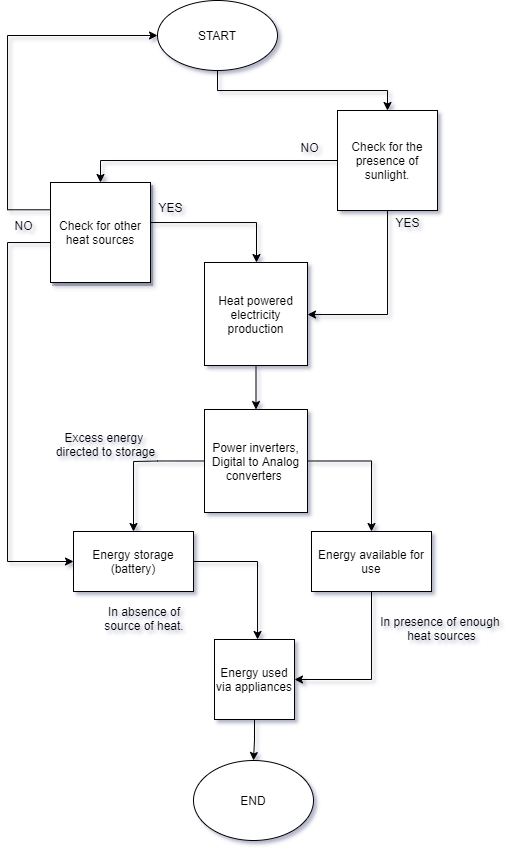Eco-friendly and Renewable Power Generation from Heat using Thermophotovoltaic Technology.
Main Article Content
Article Sidebar
Abstract
Renewable energy sources are the need of the hour, considering climate change’s impact on our planet. Although many such sources are currently being researched, none of them are commercially stable enough to compete with the existing non-renewable energy sources, with the main reason being performance for the price[1]. We believe our topic is relevant and necessary because it is essential to develop a reliable energy source to aid ongoing developments in renewable energy generation. The challenge is to accommodate the ongoing research of this technology into real systems. Restricted infrastructure development is responsible for the lag in further developments of this technology for commercial applications. We aim to develop a practical system based on the current research progress in infrared-based thermophotovoltaic power generation and storage[2]. Similar systems already exist for harnessing solar energy, but we plan to overcome the inability of solar energy to produce electricity in the absence of sunlight by developing an infrared-based system. Another challenge being the unavailability of enough thermal radiation in the vicinity to support the system from different sources. The main objectives of this work are to identify the advantages and disadvantages of such a system, its feasibility, and efficiency for working in the real world through theoretical predictions, simulation, and, if possible, experimentation. Thermophotovoltaic technology is currently under extensive research; the discovery of carbon nanotubes to capture a broad spectrum of thermal radiation and narrow it down to emit a shorter range has enabled researchers to generate power from infrared radiations[3-6]. Our proposed hypothesis is that integrating infrared-powered electricity generation can work similarly to solar energy harnessing systems. Components of a general photovoltaic system are divided into three main parts, namely solar panels, power inverter (to convert DC to AC), and batteries for energy storage[7]. For the thermophotovoltaic (TPV) system to work efficiently (by using light as an intermediary to convert heat to electricity), at least three components are required: a heat source, an emitter, and a photovoltaic (PV) cell with a low bandgap[2]. We intend to use a similar flow of components where the solar panels shall be replaced by heat-powered cells, thus allowing electricity generation when enough sunlight is not available[5]. The bigger picture of this work could be developing a system capable of producing and storing energy during the summers. The stored energy is sufficient to run during winters. Also, combining it with solar panels could give double benefit, increasing the overall absorption spectrum for an efficient generation with minimum wastage of energy present in the surroundings. Although renewable energy sources require massive infrastructure and great initial capital for setting up, they prove to be far more economical and reliable as time passes. Our project should be looked at as an investment in the future, leading the way toward a greener and cleaner planet. This is an essential step, keeping the future of the planet in mind. The use of non-renewable energy resources has already caused multiple problems across the world, like extensive scale pollution, depletion of the resources, global warming, and depletion of the ozone layer.

Fig.1.Flowchart: System workflow.
How to Cite
Article Details
[2] Tobias Burger, Caroline Sempere, Bosun Roy-Layinde, Andrej Lenert, Present Efficiencies and Future Opportunities in Thermophotovoltaics, Joule, Volume 4, Issue 8, 2020, Pages 1660-1680, ISSN 2542-4351,https://doi.org/10.1016/j.joule.2020.06.021.
[3] Vasu Prasad Prasadam, Francisco V. Ramirez, Ioannis Papakonstantinou, Ivan P. Parkin, and Naoufal Bahlawane. ACS Applied Nanomaterials 2020 3 (9), 8848-8857. DOI: https://doi.org/10.1016/j.ceramint.2021.04.017
[4] Cui, K., Lemaire, P., Zhao, H., Savas, T., Parsons, G., Hart, A. J., Adv. Energy Mater. 2018, 8, 1801471. https://doi.org/10.1002/aenm.201801471
[5] Lin, Albert & Parashar, Parag & Yang, Chien-Chih & Chou, Hao-Ming & Lin, Yi-Shiuan & Wu, Dong-Han & Chen, Yu-Bin & Tseng, Tseung-Yuen. (2018). An electrophoretic-deposited low-cost carbon nanotube (CNT) thermophotovoltaic emitter. 2905-2908. 10.1109/PVSC.2018.8547861
[6] Reyu Sakakibara, Veronika Stelmakh, Walker R. Chan, Michael Ghebrebrhan, John D. Joannopoulos, Marin Soljacic, Ivan Čelanović, "Practical emitters for thermophotovoltaics: a review," J. Photon. Energy 9(3) 032713 (26 February 2019) https://doi.org/10.1117/1.JPE.9.032713
[7] Ribeiro, P. F., Johnson, B. K., Crow, M. L., Arsoy, A., & Liu, Y. (2001). Energy storage systems for advanced power applications. Proceedings of the IEEE, 89(12), 1744-1756. DOI: 10.1109/5.975900
